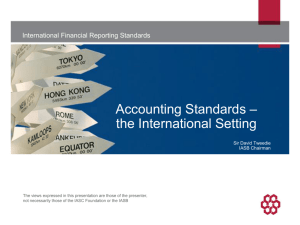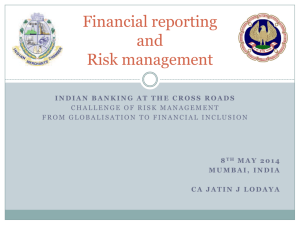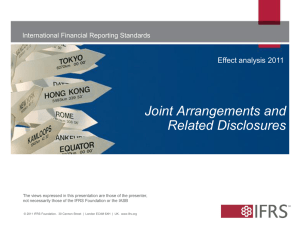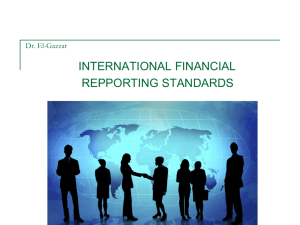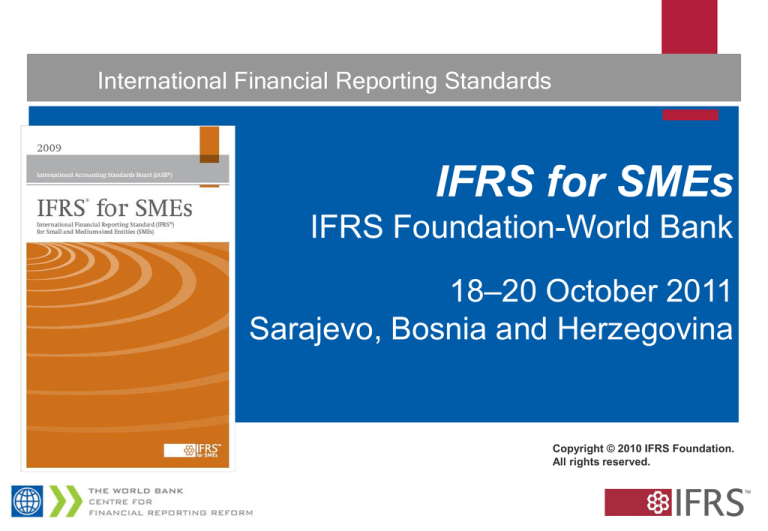
International Financial Reporting Standards
1
IFRS for SMEs
IFRS Foundation-World Bank
18–20 October 2011
Sarajevo, Bosnia and Herzegovina
Copyright © 2010 IFRS Foundation.
All rights reserved.
The IFRS for SMEs
2
Topic 2.2(b)
Quiz and Discussion
Section 12 Other Financial Inst. Issues
Section 22 Liabilities and Equity
Michael Wells
© 2011 IFRS Foundation | 30 Cannon Street | London EC4M 6XH | UK | www.ifrs.org
Section 12 – Quiz and discussion
3
Question 9: Which of the following is within the
scope of Section 12?
a.Bank loan payable, interest at LIBOR + 2%
b.Financial instrument that is designated as a
hedging instrument under IFRS for SMEs
c.Quoted fixed-interest bond
d.Obligation to pay employees 20% of profits
each year, payment 6 mos. after year-end
e.Obligation under a finance lease to pay lessor
fixed amount for 10-year lease term
© 2011 IFRS Foundation | 30 Cannon Street | London EC4M 6XH | UK | www.ifrs.org
Section 12 – Quiz and discussion
4
Question 9: Which is within scope of Section 12?
a.Bank loan payable, interest at LIBOR + 2%
b.Financial instrument that is
designated as a hedging instrument
under IFRS for SMEs
c.Quoted fixed-interest bond
d.Obligation to pay employees 20% of profits
each year, payment 6 mos. after year-end
e.Obligation under a finance lease to pay lessor
fixed amount for 10-year lease term
© 2011 IFRS Foundation | 30 Cannon Street | London EC4M 6XH | UK | www.ifrs.org
Section 12 – Quiz and discussion
5
Question 10: Which of the following are within the
scope of Section 12 (must measure at FTVPL)?
a.Trade receivables
b.5% holding in non-puttable ordinary shares of
another entity
c.30% holding in non-puttable ordinary shares of
an entity over which we have significant
influence
d.Contract to purchase 100,000 US dollars four
months from now at fixed price of 3.5 Ringgit
(our functional currency is the Ringgit)
© 2011 IFRS Foundation | 30 Cannon Street | London EC4M 6XH | UK | www.ifrs.org
Section 12 – Quiz and discussion
6
Question 10: Which of the following are within the
scope of Section 12 (must measure at FTVPL)?
a.Trade receivables
b.5% holding in non-puttable ordinary shares of another
entity
c.30% holding in non-puttable ordinary shares of an
entity over which we have significant influence
d.Contract to purchase 100,000 US dollars
four months from now at fixed price of 3.5
Ringgit (functional currency is Ringgit)
© 2011 IFRS Foundation | 30 Cannon Street | London EC4M 6XH | UK | www.ifrs.org
Section 12 – Quiz and discussion
7
Question 11: Which of the following contracts are
within the scope of Section 12?
a.Contract to buy a property in UK in 6 months that
provides for additional payment of 10% of the purchase
price if the CPI in UK increases by 1% in the 6 month
period
b.Contract to buy a property in UK in 6 months that
provides for additional payment of 1% of the purchase
price if the CPI in UK increases by 1% in the 6 month
period
Two more choices on next slide...
© 2011 IFRS Foundation | 30 Cannon Street | London EC4M 6XH | UK | www.ifrs.org
Section 12 – Quiz and discussion
8
Question 11: Two more choices...
c. Contract to sell a property in 6 months that could
result in a loss to the seller if the buyer defaults due
to financial difficulties
d. Contract to sell a property in 6 months to an
overseas buyer for 1,000,000 that could result in a
loss to the buyer if the currency in the buyer's
jurisdiction depreciates against CU during the 6
month period
© 2011 IFRS Foundation | 30 Cannon Street | London EC4M 6XH | UK | www.ifrs.org
Section 12 – Quiz and discussion
9
Question 11: Which of the following contracts are
within the scope of Section 12?
a.Contract to buy a property in UK in 6
months that provides for additional payment
of 10% of the purchase price if the CPI in UK
increases by 1% in the 6 month period
This contract imposes a leveraged (ie
speculative) inflation risk on the buyer (note
contrast with choice b).
© 2011 IFRS Foundation | 30 Cannon Street | London EC4M 6XH | UK | www.ifrs.org
Section 12 – Quiz and discussion
10
Question 12: 1/1/X0 SME buys 100 share options
for 2,000 cash. The options permit SME to buy
shares in a listed entity XYZ for 50 per share at any
time during the next 2 years. Bank charges a fee of
20. On 1/1/X0 XYZ's share price is 44. At what
amount should SME initially measure the options?
a.1,900
b.1,980
c.2,000
d.2,020
e.4,040
© 2011 IFRS Foundation | 30 Cannon Street | London EC4M 6XH | UK | www.ifrs.org
Section 12 – Quiz and discussion
11
Question 12: At what amount should SME initially
measure the options?
a.1,900
b.1,980
c.2,000 Initially measure at FV which is
usually the transaction price (¶12.7). 20
fee is expensed because will measure at
FVTPL.
d.2,020
e.4,040
© 2011 IFRS Foundation | 30 Cannon Street | London EC4M 6XH | UK | www.ifrs.org
Section 12 – Quiz and discussion
12
Question 13: Same facts as Q12. At 31/12/X0 SME
has not yet exercised the option; XYZ share price is
47; fair value of option is 2,500. At what amount
should SME measure the options at 31/12/X0?
a.1,980
b.2,000
c.2,020
d.2,500
e.4,700
© 2011 IFRS Foundation | 30 Cannon Street | London EC4M 6XH | UK | www.ifrs.org
Section 12 – Quiz and discussion
13
Question 13: Same facts as Q11. At 31/12/X0 SME
has not yet exercised the option; XYZ share price is
47; fair value of option is 2,500. At what amount
should SME measure the options at 31/12/X0?
a.1,980
b.2,000
c.2,020
d.2,500 Subsequent measurement at
fair value (¶12.8)
e.4,700
© 2011 IFRS Foundation | 30 Cannon Street | London EC4M 6XH | UK | www.ifrs.org
Section 12 – Quiz and discussion
14
Question 14: Which of following risks is not eligible
for hedge accounting under IFRS for SMEs?
a.Interest rate risk in debt instrument measured
at amortised cost
b.FX risk in debt instrument measured at
amortised cost
c.FX risk in a firm commitment
d.Interest rate risk in a firm commitment
e.FX risk in a net investment in a foreign
operation
© 2011 IFRS Foundation | 30 Cannon Street | London EC4M 6XH | UK | www.ifrs.org
Section 12 – Quiz and discussion
15
Question 14: Which of following risks is not eligible
for hedge accounting under IFRS for SMEs?
a.Interest rate risk in debt instrument measured at
amortised cost
b.FX risk in debt instrument measured
at amortised cost. FX gain/loss hits P&L
under ¶30.10. Derivative hedging
instrument is also FVTPL.
c.FX risk in a firm commitment
d.Interest rate risk in a firm commitment
e.FX risk in a net investment in a foreign operation
© 2011 IFRS Foundation | 30 Cannon Street | London EC4M 6XH | UK | www.ifrs.org
Section 12 – Quiz and discussion
16
Ques. 15: SME has inventory it plans to sell in 3
months. SME is worried about price decline during
the 3 months and so enters into forward contract to
hedge price risk of its inventory. Relationship
meets conditions for hedge accounting and SME
documents the hedge. What is the accounting?
a.Recognise forward contract as an asset or liability at
FV and change in FV in P&L. Recognise the change in
FV of the inventory in P&L and as an adjustment to the
carrying amount of the inventory.
More choices next slide...
© 2011 IFRS Foundation | 30 Cannon Street | London EC4M 6XH | UK | www.ifrs.org
Section 12 – Quiz and discussion
17
Question 15: Answer choices, continued...
b. Recognise forward contract as an asset or liability at
FV and change in FV in OCI. Recognise the change
in FV of the inventory in OCI and as an adjustment
to the carrying amount of the inventory.
c. Recognise forward contract as an asset or liability at
FV and the change in the FV of the forward contract
in OCI. Do not recognise the change in the FV of
the inventory as inventory is measured at cost.
© 2011 IFRS Foundation | 30 Cannon Street | London EC4M 6XH | UK | www.ifrs.org
Section 12 – Quiz and discussion
18
Ques. 15: What is the accounting?
a.Recognise forward contract as an asset or
liability at FV and change in FV in P&L.
Recognise the change in FV of the inventory
in P&L and as an adjustment to the carrying
amount of the inventory. Note that the
inventory is adjusted even though its
carrying amount is historical cost.
© 2011 IFRS Foundation | 30 Cannon Street | London EC4M 6XH | UK | www.ifrs.org
Section 22 – Quiz and discussion
Question 16: A financial instrument that is
designated as a hedging instrument is always
measured at Fair Value Through Profit or Loss
under Section 12?
a.True
b.False
© 2011 IFRS Foundation | 30 Cannon Street | London EC4M 6XH | UK | www.ifrs.org
19
Section 22 – Quiz and discussion
20
Question 16: A financial instrument that is
designated as a hedging instrument is always
measured at Fair Value Through Profit or Loss
under Section 12?
a.True
b.False. If it is a hedge of interest in a
recognised financial instrument, or hedge of
firm commitment or forecast transaction,
hedging instrument is measured at FV
through OCI, with subsequent recycling.
© 2011 IFRS Foundation | 30 Cannon Street | London EC4M 6XH | UK | www.ifrs.org
Section 22 – Quiz and discussion
Question 17: An entity measures equity
instruments it has issued at:
a.Cost
b.Market value of a similar instrument
c.Fair value of the cash or other resources
received or receivable
© 2011 IFRS Foundation | 30 Cannon Street | London EC4M 6XH | UK | www.ifrs.org
21
Section 22 – Quiz and discussion
Question 17: An entity measures equity
instruments it has issued at:
a.Cost
b.Market value of a similar instrument
c.Fair value of the cash or other
resources received or receivable
© 2011 IFRS Foundation | 30 Cannon Street | London EC4M 6XH | UK | www.ifrs.org
22
Section 22 – Quiz and discussion
23
Question 18: On the balance sheet, an entity
presents non-controlling interest in consolidated
subsidiaries:
a.Within equity
b.Within liabilities
c.Between liabilities and equity
d.Accounting policy choice of (a) or (c) above
(choice must be applied consistently from year to
year)
© 2011 IFRS Foundation | 30 Cannon Street | London EC4M 6XH | UK | www.ifrs.org
Section 22 – Quiz and discussion
24
Question 18: On the balance sheet, an entity
presents non-controlling interest in consolidated
subsidiaries:
a.Within equity
b.Within liabilities
c.Between liabilities and equity
d.Accounting policy choice of (a) or (c) above
(choice must be applied consistently from year to
year)
© 2011 IFRS Foundation | 30 Cannon Street | London EC4M 6XH | UK | www.ifrs.org
Section 22 – Quiz and discussion
25
Question 19: On 20/12/X4, SME A voted to split its
ordinary shares, two-for-one as of 15/1/X5. The
equity of SME a will...
a.Increase on 20/12/X4
b.Increase on 15/1/X5
c.Decrease on 20/12/X4
d.Decrease on 15/1/X5
e.Remain unchanged as a result of the stock
split
© 2011 IFRS Foundation | 30 Cannon Street | London EC4M 6XH | UK | www.ifrs.org
Section 22 – Quiz and discussion
26
Question 19: On 20/12/X4, SME A voted to split the
ordinary shares of A two-for-one as of 15/1/X5. The
equity of SME a will...
a.Increase on 20/12/X4
b.Increase on 15/1/X5
c.Decrease on 20/12/X4
d.Decrease on 15/1/X5
e.Remain unchanged as a result of the
stock split
© 2011 IFRS Foundation | 30 Cannon Street | London EC4M 6XH | UK | www.ifrs.org
Section 22 – Quiz and discussion
27
Question 20: SME A issued 100 shares to
Shareholder X in 20X2 for 50 per share. SME A
repurchased those shares from X for 45 each in
Sept. 20X4. Which of the following is true?
a.SME A’s equity will increase as a result of the share
repurchase
b.SME A’s equity will decrease as a result of the share
repurchase
c.SME A recognises a 500 gain in P&L in Sept 20X4
d.SME A defers the 500 gain and recognise it in P&L
only if and when the shares are resold
© 2011 IFRS Foundation | 30 Cannon Street | London EC4M 6XH | UK | www.ifrs.org
Section 22 – Quiz and discussion
28
Question 20: SME A issued 100 shares 50 per share
and later repurchased those shares for 45 each.
Which of the following is true?
a.SME A’s equity will increase as a result of the share
repurchase
b.SME A’s equity will decrease as a
result of the share repurchase
c.SME A recognises a 500 gain in P&L in Sept 20X4
d.SME A defers the 500 gain and recognise it in P&L
only if and when the shares are resold
© 2011 IFRS Foundation | 30 Cannon Street | London EC4M 6XH | UK | www.ifrs.org
Section 22 – Quiz and discussion
29
Question 21: In 20X6 SME A bought 80% of shares
of X for 600,000. Prepared consolidated F/S for
20X6, X7, and X8. A sold 1/4th of its holding in X in
20X9 for 250,000 (so now owns 60%). Which is true?
a. SME A recognises a gain of 100,000 on sale.
b. SME A revalues its remaining holding to FV (250,000
/ .25 x 3/4ths = 750,000) and recognises gain
(750,000 - 450,000 = 300,000) in P&L.
c. Same as (b) but recognise gain in OCI.
d. No gain, only an adjustment to equity.
© 2011 IFRS Foundation | 30 Cannon Street | London EC4M 6XH | UK | www.ifrs.org
Section 22 – Quiz and discussion
30
Question 21: Which is true?
a.SME A recognises a gain of 100,000 on sale.
b.SME A revalues its remaining holding to FV (250,000 /
.25 x 3/4ths = 750,000) and recognises gain (750,000 450,000 = 300,000) in P&L.
c.Same as (b) but recognise gain in OCI.
d.No gain, only an adjustment to equity.
© 2011 IFRS Foundation | 30 Cannon Street | London EC4M 6XH | UK | www.ifrs.org
Section 22 – Quiz and discussion
31
Question 22: In 20X6 SME A bought 40% of shares
of X for 500,000. Used cost method. In 20X9 SME A
distributes those shares as a dividend to its
shareholders pro rata. At that time:
•FV of the shares in X is 1,200,000.
•If SME A had used the equity method, the carrying
amount would have been 800,000.
Which is true?
Choices on next slide...
© 2011 IFRS Foundation | 30 Cannon Street | London EC4M 6XH | UK | www.ifrs.org
Section 22 – Quiz and discussion
32
Question 22: Answer choices...
a.SME A recognises a gain of 300,000 on the
distribution.
b.SME A recognises a gain of 700,000 on the
distribution.
c.SME A recognises a gain of 280,000 on the
distribution.
d.The distribution is an equity transaction with
shareholders and no gain or loss is recognised.
© 2011 IFRS Foundation | 30 Cannon Street | London EC4M 6XH | UK | www.ifrs.org
Section 22 – Quiz and discussion
33
Question 22: Answer choices...
a.SME A recognises a gain of 300,000 on the
distribution.
b.SME A recognises a gain of 700,000 on the
distribution. Dividend will be measured at FV
of asset distributed = 1,200,000.
c.SME A recognises a gain of 280,000 on the
distribution.
d.The distribution is an equity transaction with
shareholders and no gain or loss is recognised.
© 2011 IFRS Foundation | 30 Cannon Street | London EC4M 6XH | UK | www.ifrs.org
Section 22 – Quiz and discussion
34
Question 23: 1/1/X1 SME A issues at par a 5% tenyear convertible bond. Par and maturity amount =
100,000. If no conversion feature, SME A would
have paid 12%. Which is true?
a.The bond liability at 31/12/X1 shown in the balance
sheet will be 100,000
b.The bond liability at 31/12/X1 shown in the balance
sheet will be greater than 100,000
c.Interest expense for X1 will be greater than 5,000
d.Interest expense for X1 will be less than 5,000
e.Interest expense for X1 will be exactly 5,000
© 2011 IFRS Foundation | 30 Cannon Street | London EC4M 6XH | UK | www.ifrs.org
Section 22 – Quiz and discussion
35
Question 23: Which is true?
a.The bond liability at 31/12/X1 shown in the balance
sheet will be 100,000
b.The bond liability at 31/12/X1 shown in the balance
sheet will be greater than 100,000
c.Interest expense for X1 will be greater than
5,000. Interest expense will be 5% x 100,000
plus amortisation of discount using effective
interest method.
d.Interest expense for X1 will be less than 5,000
e.Interest expense for X1 will be exactly 5,000
© 2011 IFRS Foundation | 30 Cannon Street | London EC4M 6XH | UK | www.ifrs.org
Questions or comments?
Expressions of individual views by
members of the IASB and its staff
are encouraged.
The views expressed in this
presentation are those of the
presenter.
Official positions of the IASB on
accounting matters are determined
only after extensive due process
and deliberation.
© 2011 IFRS Foundation | 30 Cannon Street | London EC4M 6XH | UK | www.ifrs.org
36
37
This presentation may be modified from time to time. The
latest version may be downloaded from:
http://www.ifrs.org/IFRS+for+SMEs/SME+Workshops.htm
The accounting requirements applicable to small and
medium-sized entities (SMEs) are set out in the
International Financial Reporting Standard (IFRS) for SMEs,
which was issued by the IASB in July 2009.
The IFRS Foundation, the authors, the presenters and the
publishers do not accept responsibility for loss caused to
any person who acts or refrains from acting in reliance on
the material in this PowerPoint presentation, whether such
loss is caused by negligence or otherwise.
© 2011 IFRS Foundation. 30 Cannon Street | London EC4M 6XH | UK. www.ifrs.org

